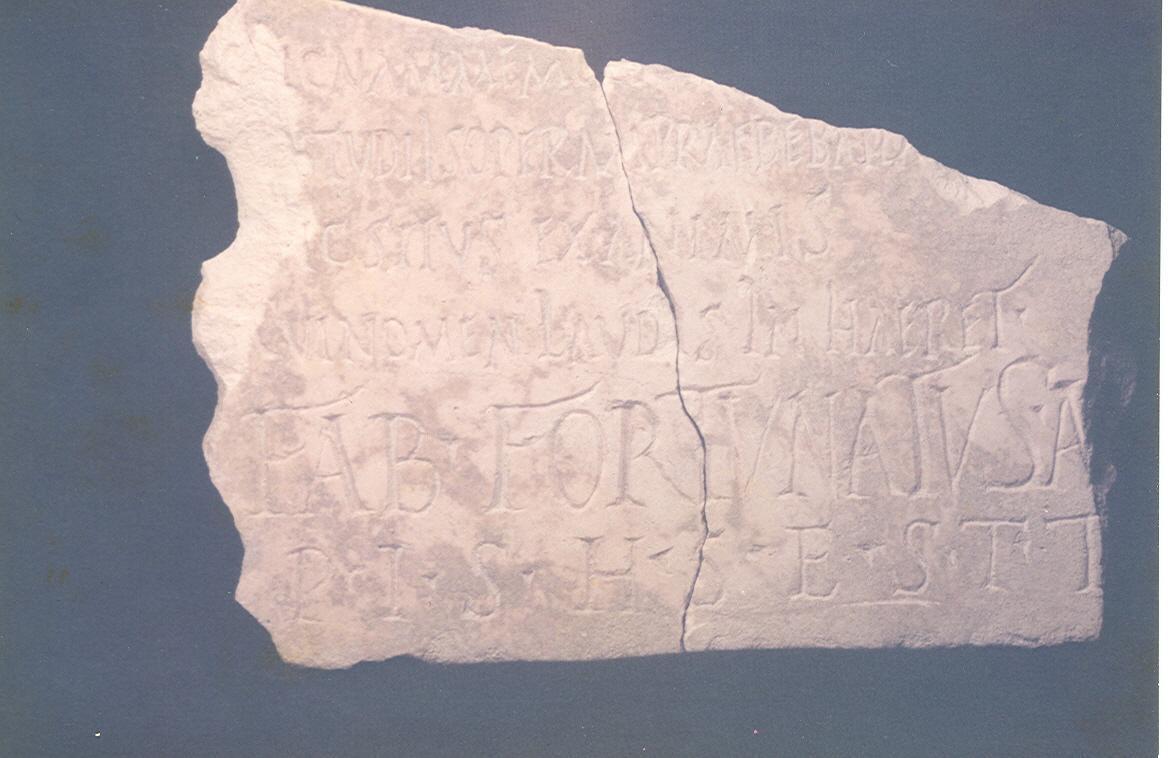Epitaph of Fabio Fortunato
Reference CIL II2/5 1210 | Description | Lyrics | Location | Chronology | Epigraphic edition | Translation | Apparatus | Comentary | Type of verse | Text divided into verses and metric signs | Images | Bibliography | Link to DB | Author |
Epitaph of Fabio Fortunato
Description
- Idno filename 22/01/0055
- Type of inscription: Sepulcralis
- Material Description: Prof. Chic saw it and described it as Placa de caliza o mármol amarillento (Tablet of limestone or yellowish marble).
- Conservation status: Broken at three points.
-
Epigraphic field:
- Layout: It appears to preserve all the lines of the text. Triangular interpunctions in the subscriptum; in the poem, only after inhaeret (possibly to indicate the end of the carmen).
- Lost
Lyrics
- Font:Libraria
- Description of the letters:The subscriptum is written in larger letters than the carmen. Letter <A> in the carmen has no crossbar, unlike those of the subscriptum.
Location
- Place of discovery: Found in the mid 1980s in an estate on the outskirts of Écija at the beginning of the road to Lucena in the direction of Córdoba, next to the Necrópolis del Puente.
- Geolocation
- Location with Modern Nomenclature España / Sevilla / Écija
- Location with Old Nomenclature Hispania / Baetica / Astigitanus / Astigi
Chronology
- Inscription's dating: Between year 101 and year 199
- Dating explanation: From the paleography it could date from the 2nd c. AD.
Type of verse
- Type of verse: Dactílico (hexámetro)
- Verse/line correspondence: No
- Prose/verse distinction: Si
Epigraphic edition
——
ṣic nam memor + [‑ ‑ ‑]
studiìs operam praebebat +[‑ ‑ ‑]
[h]ic situs exanimis
5 cui nomen laudis in haeret ▴
¿[-1- ·]? Fab(ius) ▴ Fortunatus ▴ a[n(norum) ‑ ‑ ‑]
p(ius) ▴ i(n) ▴ s(uis) ▴ h(ic) ▴s(itus) ▴ e(st) ▴ s(it) ▴ t(ibi) ▴ t(erra) [l(evis)]
Text divided into verses and metric signs
– – – – – –
[- – -] sic, nam memor [- – -] [ln|ln]l||lkk|[lkk|~]
[- – -] studiis operam praebebat [- – -] [ln|l]/kk|l/kk|l/l|lk[k|l~]
[- – -] hic situs exanimis [ln|ln|l]||lkk|lkk|~
5 [- – -] cui nomen laudis inhaeret. [ln|ln|l]/l|ll|lkk|l~
Translation
[...] he was dedicated to his studies [...] Here he lies lifeless [...] whose name is associated with praise. Fabius Fortunatus, of [...] years [...], dutiful to his family, is buried here. May the earth rest (lightly) on you.
Bibliography
Ordóñez Agulla 1988, 165 (inde Pastor 1988, 181 adn. n. 217; HEp 1993, 340; González Fernández, CILA II, 809; González Fernández, II2/5, 1210; Martín Camacho 2004 cum phot.); Martín Camacho in Fernández Martínez, CLEB, SE19 cum imp. phot., qui in linguam Hispanicam vertit; Cugusi 2012, 53. – Cf. Hernández Pérez 2001a, 56. 58. 189–190.
Apparatus
1 memor [—]González Fernández II2/5. – 2 praebeba[t—]González Fernández II2/5. – 4 [h]ic situs ex animis cui nomen laud[i]s in haeret [—]Ordóñez Agulla, inhaeret González Fernández II2/5 .
Comentary
Dactylic rhythm, but it is impossible to tell whether it is in hexameters with pentameters or hexameters alone. L. 1 memor emphasises the idea of not letting the deceased fall into oblivion (cf. CLE 385,6; Gómez Pallarès PEPC, T5,9). L. 2 describes what the deceased did: studiis probably refers to the study of the liberal arts (cf. Suet. hist. 80,4; Tac. dial 37,3; or Iust. dig. 1,2, 2, 47,4: plurimum studiis operam dedit); L. 4 possibly reinforces this idea, as it contains one characteristic feature of these epitaphs: the deceased earned universal praise in life and vanquishes death through his renown (on the survival of fame, cf., based on Verg. ecl. 5,78 and Aen. 1,609, CLE 1786c, 3; CLE 2047,3); on the deceased as an example of praise, cf. CLE 437,15; CLE 1974,2.
Author
- Author:J. Martín Camacho
- Last Update2024-02-25 18:32:13
You can download this






